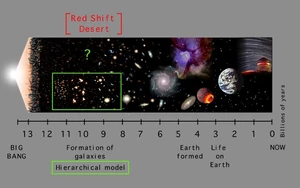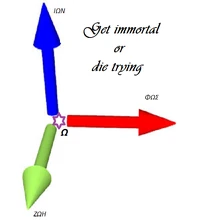Κυριαρχία Σκοτεινής Ενέργειας

Αρχαιο-Κοσμολογική Εποχή Very Early Universe era
Μεγάλη Έκρηξη Big Bang
Περίοδος Planck Planck epoch
Χρωμοηλεκτρασθενής Περίοδος Grand unification epoch
Ηλεκτρασθενής Περίοδος Electroweak epoch
Παλαιο-Κοσμολογική Εποχή Early Universe era
Κυρκονική Περίοδος quark epoch
Αδρονική Περίοδος Hadron epoch
Λεπτονική Περίοδος Lepton epoch
Φωτονική Περίοδος Photon epoch
Μεσο-Κοσμολογική Εποχή Middle Universe era
Κοσμική Βιοχημική Περίοδος Habitable epoch
Κοσμική Σκοτεινή Περίοδος Dark ages
Υστερο-Κοσμολογική Εποχή Last Universe era
Αστρογένεση Formation of stars Γαλαξιογένεση Formation of galaxies Σμηνογένεση Formation of clusters and superclusters
Νεο-Κοσμολογική Εποχή New Universe era
Ηλιογένεση Formation of the Solar System Γαιογένεση Formation of the Earth
Μετα-Κοσμολογική Εποχή Ultimate Universe era
Ηλιακός Όλεθρος Solar Ruination
Μεγάλη Απόσχιση Big Rip
Μεγάλη Συρρίκνωση Big Crunch
Μεγάλη Ψύξη Big Freeze
Θερμικός Θάνατος Heat Death
- Μία Κοσμολογική Περίοδος.
Ετυμολογία[]
Η ονομασία "Ενεργειοκυριαρχία" σχετίζεται ετυμολογικά με την λέξη "κυριαρχία".
Εισαγωγή[]
In physical cosmology, the dark-energy-dominated era refers to the last of the three phases of the known universe, the other two being the matter-dominated era and the radiation-dominated era. The dark-energy-dominated era began after the matter-dominated era, i.e. when the Universe was about 9.8 billion years old.[1] As other forms of the matter – dust and radiation – dropped to very low concentrations, the cosmological constant term started to dominate the energy density of the Universe.
For a dark-energy-dominated universe, the evolution of the scale factor in the Friedmann-Lemaître-Robertson-Walker metric is easily obtained solving the Friedmann equations:
Here, the coefficient H in the exponential, the Hubble constant, is
This exponential dependence on time makes the spacetime geometry identical to the de Sitter Universe, and only holds for a positive sign of the cosmological constant, the sign that was observed to be realized in Nature anyway. The current density of the observable universe is of the order of 9.44 x 10−27kg m−3 and the age of the universe is of the order of 13.8 billion years, or 4.358 x 1017s. The Hubble parameter, H, is ~70.88 km s−1Mpc−1. (The Hubble time is 13.79 billion years.) The value of the cosmological constant, Λ, is ~2 x 10−35s−2.
Υποσημειώσεις[]
- ↑ Ryden, Barbara, "Introduction to Cosmology", 2006, eqn. 6.33
Εσωτερική Αρθρογραφία[]
- Σύμπαν
- Εξελικτική Θεωρία
- Κοσμολογική Εξέλιξη
- Αδρονική Περίοδος (Hadron epoch)
- Λεπτονική Περίοδος (Lepton epoch)
- Φωτονική Περίοδος (Photon epoch
- Νουκλεοσύνθεση (Nucleosynthesis)
- Υλοκυριαρχία (Matter domination)
- Κοσμική Ανασύνθεση (Recombination)
Βιβλιογραφία[]
Ιστογραφία[]
|
Αν και θα βρείτε εξακριβωμένες πληροφορίες "Οι πληροφορίες αυτές μπορεί πρόσφατα Πρέπει να λάβετε υπ' όψη ότι Επίσης, |
- Μην κάνετε χρήση του περιεχομένου της παρούσας εγκυκλοπαίδειας
αν διαφωνείτε με όσα αναγράφονται σε αυτήν
- Όχι, στις διαφημίσεις που περιέχουν απαράδεκτο περιεχόμενο (άσεμνες εικόνες, ροζ αγγελίες κλπ.)


